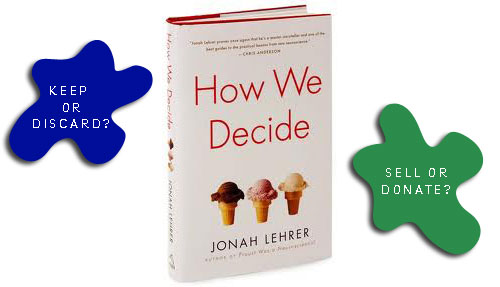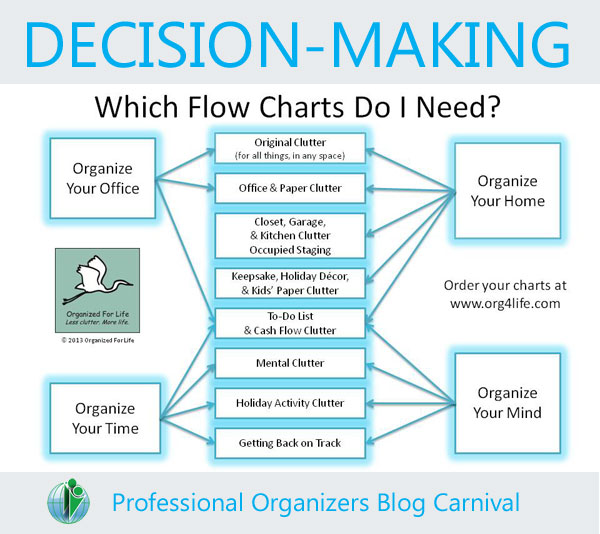The Plan: A Practical Tool for Working with Clients and their Goals
This page may contain links to Amazon.com or other sites from which I may receive commission on purchases you make after clicking on such links. Read my full Disclosure Policy

I met Alison Lush at the POC Conference in 2010, where I had the honor of speaking about Social Media Strategies for Professional Organizers. She contacted me recently to ask if I thought you’d be interested in learning about a tool she created for working with a chronically disorganized client – naturally, I said “Yes!”

My name is Alison Lush and I am a Professional Organizer in Montreal, Quebec, Canada.
Last fall I created an Excel spreadsheet for the use of my client and myself. At the time, I had been working with my client for six months. She is:
- a 55-year old professional, fully employed and highly functioning individual employed in television;
- self-aware, complex and intelligent;
- creative and predominantly visual;
- living alone, independent and handy;
- very sensitive emotionally and psychologically, prone to migraines and back problems as well as emotional turmoil, and
- overwhelmed (her 5-room apartment is a Level II hoard), but
- motivated.
From the beginning of our work together it was clear that my client wanted to direct our sessions and she needed our work to progress quite slowly. One day I received an e-mail from her saying she wanted to cancel our next appointment because she had been unable to “plan” our next project. I responded congratulating her for having thus far successfully directed our work together and asked if she would feel comfortable allowing me to direct our next session to allow her a break. She agreed.
To help my client identify her goals, I created an Excel spreadsheet entitled “The Plan” with one page for each room in her apartment.
Phase One – Visualizing Brain Dump
- I brought my laptop to our next appointment and “interviewed” my client.
- Proceeding room-by-room, I asked my client to visualize what specific changes or improvements she wanted to achieve (quantification and simplification of her goals). As she talked, I captured her words on the spreadsheet.
- For each item, together we elaborated a list of descriptors identifying how the change would affect her life (qualification).
- As all the goals and the language were created or approved by my client, the information on the chart is an extremely personal external manifestation of where she wants to go, empowering her and embracing her unique vision.
- This exercise took two hours. My client reported being very surprised at the project I had created and very pleased at having done it.
Phase Two – Goal Definition
- The following week I returned with my laptop; I had added three columns to the spreadsheet.
- We spent our session going through the items and expanding their descriptions;
- “The change will add ______ to my life” (1 = a little, 2 = medium benefit, 3 = a lot)
- Cost ($ = little, $$ = medium cost, $$$ = expensive)
- Complexity (green “light” means we could just do it, yellow “light” means there are some obstacles that must be dealt with first, and red “light” means significant obstacles)
- As we were filling out these details, my client was very animated. She kept using the word “Wow” to describe the impact certain changes would add to her life. Building on this concept, I created another column to record her “Wows”. She then wanted different sized Wows and she chose the colour.
- This exercise took 2 hours, and at the end my client reported being “very excited”.
Phase Three – Refocusing and Prioritizing
- Refocusing and Prioritizing: Over the following months, at several points, my client felt unsure about what part of her apartment she wanted to work on. We would open up “The Plan” and read through the document to refresh her vision and help her choose which project to undertake.
- Client Values Become Clearer: As we were reviewing the document, I noticed and pointed out the theme of cleared floors being of great importance. My client’s eyes widened and her jaw dropped. Since then, we’ve been able to use this improved understanding of her values to help make the best choices and maximize the benefit of the work we’re doing.
- Reality Checks: One day, my client latched on to her goal of creating an island in the kitchen and she became animated about jumping-in to make it happen. I responded by asking her if that would really be such an easy project, she responded yes. When challenged, she seemed surprised, and I invited her to turn her head and look at the kitchen where the island would go. It was as if she had donned prescription glasses and suddenly saw clearly what she had been fantasizing about. We opened The Plan and she saw that she had evaluated that goal as being very expensive and highly complex. The Plan served as a reality check, but because it was in her own words, it was even more powerful for her.
Fine Tuning: Sometimes my client has had me add items to the original goal list.
Phase Four – Checkpoints and Celebration
- Checkpoints: Adding the details of task completion to The Plan is very important to my client.
- Celebration: I suspect that it is all too easy for her to forget her accomplishments in view of the work remaining to be done, and having her fine work noted makes it more real for her (invigorating checkpoints). Regardless of the enormity of the challenges still in front of her, my client IS making real progress toward her chosen future.
Conclusion
By creating this tool, I provided my client with a methodology for a visualizing “brain dump”, and once the information was captured and elaborated, the tool became both an anchor and a guiding light for her and for our work together.
Using “The Plan” has helped our work in many ways;
- Goal identification, simplification, quantification, qualification
- Embracing and honouring the emotional experience of my client
- Externalizing her goals has made it much easier for me to understand where she wants to go and to maximize the help I can bring to the project.
- This is a tool that my client can certainly employ with different challenges in her life: because this exercise can be accomplished alone, my client is empowered by having it in her toolbox.
I am eternally grateful that this client and I found each other. With other clients I did not have the inspiration to create this tool, and this client’s ability and willingness to participate in this process has really made it a joint venture. I hope this tool may serve useful or inspirational to other Professional Organizers and their clients. Please contact me to request a copy of The Plan.
Image © HypnoCreative / Crestock.




Alison, thanks a lot for this ‘plan’!!! Will definitely help a lot.
Thank you for your comment Josh.
If you’d like a copy of The Plan itself (Excel document) don’t hesitate to drop me a line!
Alison
Hi Alison,
I really enjoyed reading this post, and meeting you through it in the process 🙂
This story is helpful for me because it is similar to the work I’m doing with a coaching client right now and it’s a nice reminder about how long someone needs to process and realize their journey. This individual is also a professional creative and his home work space needs to reflect a big shift coming up in his life.
I love your Plan idea! Mapping is a big part of what I do – in this case my client danced around the space, imagining the flow and purpose that would serve him and then he engaged with drawing an elegant ‘blueprint’ on a large sheet of paper, giving each area a meaningful name. (He hangs it in a special place and calls it his inspirational art work 😉 Then all the details followed, with a similar rating system of priorities and possibilities. Beautiful!
Your point is well taken about having this plan to refer to. I have only had our second meeting regarding this project and it was very helpful for my client to be re inspired by his image yet also reminded of his choices. Of course, people can change their minds so already he has found an improvement to his design.
Thank you for the opportunity to reflect on my work!
Jo
Hi Jo
I’m delighted that you found my story about The Plan interesting!
Please do let me know if you would like me to send you the Excel copy.
All the best, Alison
Sounds like a great tool Alison! Don’t you love when the creation of a tool for one particular client turns into a system you can use for future client’s as well. That’s growth!
Yes, Rachael, it is quite exciting to create a solution for one client that becomes a tool for others!
A+
Alison